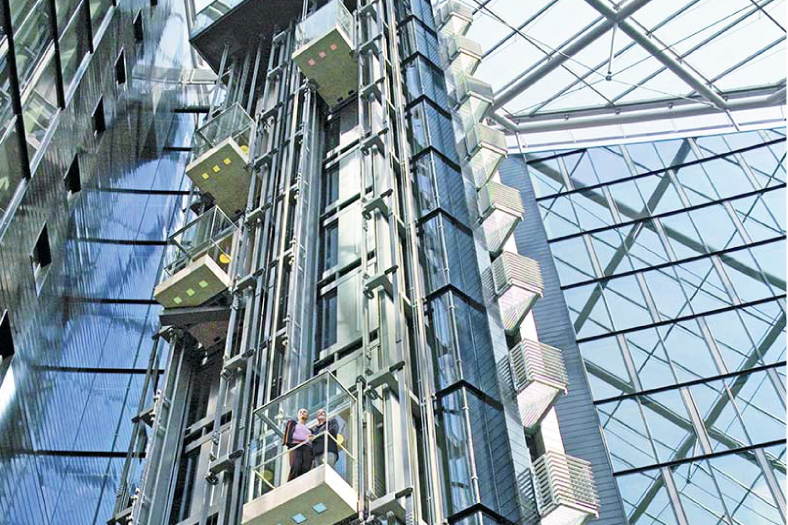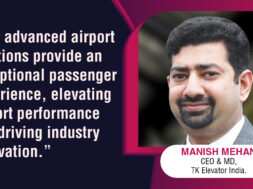
Utilising variable voltage motor controllers or VF drive can result in notable energy savings of the system.
Buildings consume 40 per cent of the world’s energy. New elevator technologies are capable of considerable energy savings, and in some cases, elevators are a key element in making buildings self-sufficient in energy. Additionally, lift loads can also be made energy efficient. Lifts consume energy even when not raising or lowering loads, and can represent over 90 per cent of the total electricity consumption in lifts with a low number of daily trips. Further, control systems, lighting, ventilation, floor displays and operating consoles, aid in energy savings owing to constant working.
Variable voltage motor controller
Switching off equipment or putting on low energy mode is a way to save energy. Lift shaft can facilitate thermal losses from the building and correct insulation around the entire heated volume should be ensured to avoid such losses. The shaft and machine room should be well insulated and flaps in the air vents should also be airtight. Alternatively, lift shaft can also be located entirely on the outside of the heated volume with the lift doors leading to unheated spaces or to the outside.
Bharat Vishnani, Managing Director, thyssenkrupp Elevator (India) Pvt Ltd says, “Installing variable speed drives or use of variable voltage motor controllers can result in energy savings of 15-40 per cent. This alternative is useful with medium traffic. Regenerative braking can be employed on heavily used down escalators and finally, LED light sources can be installed for skirt guard, comb, and rail lighting. Lighting improvements alone can result in 1,600 – 2,000 kWh/year of energy savings.”
Service and maintenance improves lifetime
To improve the life of equipment and elements and maintaining performance, continuous service is essential. Sebi Joseph, President, Otis India says, “Existing elevators can be made energy efficient by adding the Variable Frequency Drives (VF drive) in the door system and elevator control system.”
Another way to optimise energy in buildings with multiple elevators is grouping passengers going to the same or nearby floors into the same elevator. This allows the elevator with the least load and/or closest to attend to the passenger call.
Incorporating in-cab sensors
In-cab sensors accompanying software allows elevators to enter an idle mode when not in use. This means that lights turn off, ventilation system slows down and video screens turn off when elevator is empty. According to Vimal R.Babu, Co Founder & Director of Sales, Elite Elevators Thyssenkrupp, “Drive system must be applicable in order to reduce the use of ropes, chains and pistons. This eventually reduces the dependency on high power machines excluding space occupancy for machines.”
Use of Variable Voltage Variable Frequency (VVVF) Drives allows less power consumption during the busy mobility of an elevator. In case of multi-facility building, elevators work in a group operation. Schindler has further advanced this feature with optimal programming of elevators called destination control system (DCS) that optimises people mobility within buildings.
Vaibhav Pitale, Sr. Vice President – New Installation Business, Schindler India Pvt Ltd says, “PORT transit management system interconnects the entire building and provides architects with new possibilities in vertical mobility management and security planning.”
Difference in design
Key features of energy-efficient elevators are deployment of permanent magnet synchronous (PMS) gearless traction machines and usage of regenerative drive technology. Light-emitting diodes (LED) in elevator cabs and escalators provide the same luminance as traditional lights and a lifetime 10 times longer emitting low heat and minimal radiation, says Vishnani.
This pares energy consumption by up to 75 per cent under normal operating conditions. The elevator leader has introduced standby modes in its elevators that understands the usability with a press of a button or sensors to detect movement, and cuts down the standby use by over 75 percent.”
Aesthetic appeal of green elevators
High-quality materials and attractive colours can make a striking statement and enhance green escalator’s overall appeal. Furthermore, from the outer cladding and the decking to the balustrade glass and the handrail, every design detail can be made customisable, says Vishnani.
Otis has launched two aesthetic design themes namely Aura and Atmos that reflect Indian warmth and culture as well as the new age, modern India. Aura elevators have intricate mirror patterns lending a warm and welcoming feel. The Atmos elevator range has cool colours and soft lighting that provide a sense of ample space.
Schindler 5500 and 7000 elevators are compatible with the requirements of commercial, mid and high-end residential buildings. Ranges include premium car decor finishes, customisable buttons, mechanical push style buttons, among others.
According to Ar. S.P. Anchuri, Chief Consultant, Anchuri & Anchuri, to encourage environmentally responsible forest management, at minimum of 50 per cent of wood-based -certified, such as the wood panelling in the elevator cab or the base platform. Low emitting materials, paints and coatings; to reduce the quantity of indoor air contaminants only paints are to be applied during the installation or repair. To reduce the quantity of indoor air contaminates, use composite woods that contain no added urea-formaldehyde resins. Sustainable elevator design would continue to gain prominence for everyone involved in building design.
Considerations while constructing and designing
Travel height or distance, speed, capacity, elevator door type, power supply needs, finishes and fixtures, seismic provisions for elevators etc are the factors to be considered while constructing and designing elevators and escalators. For escalators rise, pallet width, inclination, balustrade height, indoor or outdoor application for infrastructure or commercial projects should be considered, says Vishnani.
Load and capacity requirements, number of people in a building, traffic patterns are key requirements. Speed is directly related to the number of floors in a building. Other aspects include safety systems like the automatic rescue system, infra-red door curtains, load weighing device etc. Further, from quality stand point, the systems could be evaluated on the basis of ride quality alongside reduced noise and vibration. Integrated security systems are also being widely considered this day and age, says Joseph.
Key considerations for design include ease of access for users, compliance with residential safety standards as per the guidelines of MD 2006 42 EC, EN81-41 and TUV, backup facilities in case of emergency, embedded with fire and safety alarm system, design. Also, depending on aspects like location, size, site condition, lift design will also vary practically and aesthetically, and both must work together with safety guaranteeing design that suits the building and its occupiers.
To reduce the quantity of indoor air contaminates, use composite woods that contain no added urea-formaldehyde resins.
Ar. S.P. Anchuri, Chief Consultant, Anchuri & Anchuri
The innovative drive system must be applicable in order to reduce the use of ropes, chains and pistons.
Vimal R. Babu, Co Founder & Director of Sales, Elite Elevators Thyssenkrupp
Existing elevators can be made energy efficient by adding the Variable Frequency Drives (VF drive) in the door system and elevator control system.
Sebi Joseph, President, Otis India
Installing variable speed drives or use of variable voltage motor controllers can result in energy savings of 15-40 per cent.
Bharat Vishnani, Managing Director, thyssenkrupp Elevator (India) Pvt Ltd
PORT transit management system interconnects the entire building and provides architects with new possibilities in vertical mobility management and security planning.
Vaibhav Pitale, Sr. Vice President – New Installation Business, Schindler India Pvt Ltd
Cookie Consent
We use cookies to personalize your experience. By continuing to visit this website you agree to our Terms & Conditions, Privacy Policy and Cookie Policy.









